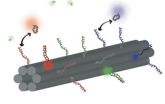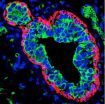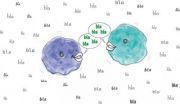(Press-News.org) TEMPE, Ariz. – Scientists at Arizona State University have discovered that ants utilize a strategy to handle "information overload." Temnothorax rugatulus ants, commonly found living in rock crevices in the Southwest, place the burden of making complicated decisions on the backs of the entire colony, rather than on an individual ant.
In a study published in the early, online version of scientific journal Current Biology, Stephen Pratt, an associate professor in ASU's School of Life Sciences in the College of Liberal Arts and Sciences, and Takao Sasaki, a graduate student in Pratt's lab, suggest that the key to preventing cognitive overload is found in collective decision-making, rather than in multi-tasking.
"I think the reason people are interested in this is because as humans, we can become overloaded with information — and that can possibly be detrimental both to our health and to how effectively we make decisions," Pratt said. "There's a sense that as a society, we are being more and more overwhelmed by information."
Previous research has shown that ant colonies have the ability to compare the quality of two potential nest sites — even if no single ant visits both sites. Pratt and Sasaki hypothesized that a colony could choose a high-quality nest from many more options more effectively than individual ants, because each member of the colony assesses only a small part of portion of available sites, and then shares the information with the entire colony.
"People usually think of ants as sort of stupid, that they can't really compare options, or that they don't have good cognition," said Sasaki. "But actually, individual ants can compare options, and that's why they too experience cognitive overload — a well-documented phenomenon in human beings."
The pair designed experiments with artificial nest sites to evaluate the ants' decision-making abilities. Both colonies and individual ants were given two levels of tasks. Ants had to choose between two nests, or they had to choose among eight nests. In both experiments, half the nests were unsuitable. Nests are frequently chosen based on entrance and cavity size, as well as darkness and other features.
Researchers discovered that individual ants made much worse decisions when faced with eight options rather than two, meaning that they experienced cognitive overload. Colonies, on the other hand, did equally well with either two or eight options, showing that they could handle the harder problem as a collective.
The study shows what Pratt believes to be the answer to two questions: What do you get out of being a collective intelligence? And secondly, why and how is a group smarter than an individual?
"Living in a group is costly in many ways, so ants must get some benefit from doing it," said Pratt. "By sharing the burden of decision-making, colonies avoid the mistakes that a solitary animal makes when taking on too much information. What's great about these ants is that we can see exactly how they do this, by making sure that no ant has to process more information than it is able to."
Pratt added that this is one problem ants can solve, but that there are other problems ants face that we might be able to learn from.
"What we really want is a more complete understanding as to how this society works as a kind of distributed brain," Pratt said. He believes their research may provide insight into how to handle information excess in society and will have applications in collective robotics.
###
This study was supported by grants from the National Science Foundation (1012029) and the Arizona State University Graduate Research Support Program.
END
VIDEO:
DNA origami is a process that can be used to self-assemble shapes that are of nanometer dimensions -- 100 nanometers is about 1,000 times shorter than the width of an...
Click here for more information.
BOSTON, September 24, 2012—Much like the checkout clerk uses a machine that scans the barcodes on packages to identify what customers bought at the store, scientists use powerful microscopes and their own kinds of barcodes to help them identify various parts of a cell, ...
New York, NY and Uppsala, Sweden, September 24, 2012 – Death plays a big role in keeping things alive. Consider the tightly orchestrated suicide of cells--a phenomenon essential to everything from shaping an embryo to keeping it free of cancer later in life. When cells refuse to die, and instead multiply uncontrollably, they become what we call tumors. An intricate circuitry of biochemical reactions inside cells coordinates their self-sacrifice. Tracing that circuitry is, naturally, an important part of cancer research.
In a major contribution to that effort Dr. Ingvar ...
SAN DIEGO (Sept. 24, 2012) – Healing touch combined with guided imagery (HT+GI) provides significant clinical reductions in post-traumatic stress disorder (PTSD) symptoms for combat-exposed active duty military, according to a study released in the September issue of Military Medicine.
The report finds that patients receiving these complementary medicine interventions showed significant improvement in quality of life, as well as reduced depression and cynicism, compared to soldiers receiving treatment as usual alone.
The study, led by the Scripps Center for Integrative ...
ANN ARBOR, Mich.—In the first study to detail the health of Pacific Islanders living in the United States, University of Michigan researchers have found alarmingly high rates of obesity and smoking.
The preliminary findings are being presented today (Sept. 24) at a conference in Los Angeles on health disparities among Native Hawaiians and Pacific Islanders.
"Native Hawaiians and Pacific Islanders are the second fastest growing minority population in the U.S.," said Sela Panapasa, a researcher at the U-M Institute for Social Research and principal investigator of the ...
New research from the University of Copenhagen and Copenhagen University Hospital shows that low levels of vitamin D are associated with a markedly higher risk of heart attack and early death. The study involved more than 10,000 Danes and has been published in the well-reputed American journal Arteriosclerosis, Thrombosis and Vascular Biology.
Vitamin D deficiency has traditionally been linked with poor bone health. However, the results from several population studies indicate that a low level of this important vitamin may also be linked to a higher risk of ischemic heart ...
Satellite measurement of sea surface temperatures has yielded clear evidence of major changes taking place in the waters of Australia's Great Barrier Reef over the past 25 years, marine scientists have found.
The changes have big implications for the future management of the GBR and its marine protected areas say Dr Natalie Ban and Professor Bob Pressey of the ARC Centre of Excellence for Coral Reef Studies and James Cook University, who led the study with Dr Scarla Weeks from the University of Queensland.
"When we looked back at satellite data collected since 1985, ...
A new multi-national survey reveals the extent of misconceptions about when is the right time to start taking action to prevent cardiovascular disease (CVD). In a four-country survey sample of 4,000 adults, 49 per cent answered age 30 years or older when asked at what age they believe people should start to take action about their heart health to prevent conditions such as heart disease and stroke. The fact is that CVD can affect people of all ages and population groups, and the risk begins early in life through unhealthy diets, lack of physical activity and exposure to ...
It is much harder to keep up with a conversation in a crowded bar than in a quiet little café, but scientists wishing to eavesdrop on cells can now do so over the laboratory equivalent of a noisy room. A new method devised by scientists at the European Molecular Biology Laboratory (EMBL) in collaboration with the German Cancer Research Centre (DKFZ), both in Heidelberg, Germany, provides a new approach for studying the proteins cells release to communicate with each other, react to changes, or even to help them move. Published online today in Nature Biotechnology, the work ...
Researchers at the University of Gothenburg have discovered that a chemical can trigger the maturation of small eggs to healthy, mature eggs, a process that could give more women the chance of successful IVF treatment in the future. The results have been published in the revered journal PloS ONE.
Women and girls treated for cancer with radiotherapy and chemotherapy are often unable to have children as their eggs die as a result of the treatment.
Although it is now possible to freeze eggs and even embryos, this is not an option for girls who have yet to reach puberty. ...
Researchers at the Sahlgrenska Academy, University of Gothenburg, Sweden, have identified a molecule in the immune system that could affect hunger and satiety. The researchers hope that new treatments for obesity will benefit from this finding.
Interleukin-6 is a chemical messenger in our immune system that plays an important role in fighting off infection. However, recent research has, surprisingly, shown that it can also trigger weight loss. Researchers at Sahlgrenska Academy, University of Gothenburg, have been investigating and managed to identify the specific types ...


